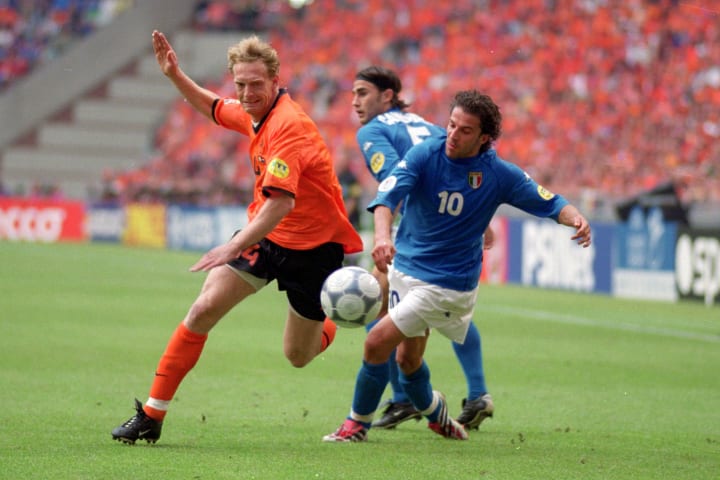
Where are they now? Italy’s Euro 2000 squad
The Italy side who lost in the final of the European Championships 20 years ago is one of the best to never win the competition.
Many of them would go on to redeem themselves with a World Cup win in 2006, but the missed opportunity at Euro 2000 still rankles with many of an Azzurri persuasion.
Their run to the final saw them concede just one goal under Dino Zoff, while a star-studded host of attacking talent set the continent alight with some of the finest counter-attacking football the Euros have ever seen.
Here, 90min takes a look back at the 22 players, and what happened next in their respective careers.
Francesco Toldo – With Gianlugi Buffon breaking his hands just days before the tournament opener, Toldo took the gloves for the rest of the tournament and performed admirably. He’s kept a low profile since retiring with some media work in Italy keeping him ticking over.
Christian Abbiati – Abbiati was one of the best around at his peak in the early 2000s, but was pretty much always second-choice for Italy. He only managed four caps for his country, but remains a storied figure at AC Milan, where he now works as a player liason officer.
Francesco Antonioli – Never managed a cap for Italy and was drafted in as a late replacement for Buffon. Now a goalkeeper coach at Cesena in Serie C.

Fabio Cannavaro – Captained his country to the World Cup in 2006, won the Ballon d’Or, and retired as Italy’s most capped outfield player of all time. A good career. Enjoyed a formidable coaching career in Asia and has managed Guangzhou since 2017.
Paolo Negro – An understated but highly-respected member of the squad in 2000, despite managing just eight caps for his country in total. The defender was a fixture in Serie A for nearly two decades and is currently a youth coach at Cragnotti FC in Serie D.
Ciro Ferrara – The former Napoli and Juventus defender was coming to the tail end of his career in 2000 and retired from international duty shortly after the tournament. But he did win two more Serie A titles with Juve, before settling into a steady coaching career, and notably started the cancer charity Fondazione Cannavaro Ferrara with former teammate Cannavaro.
Alessandro Nesta – Widely regarded as the best tackler ever, Nesta was just coming into his peak at Euro 2000. He went on to sign for Milan in 2002, and managed Frosinone until his sacking earlier this year.
Mark Iuliano – Enjoyed the peak of his career at Juventus between 1997-2005 and broke into the Italy squad at the height of that. Managed three teams in Italy and is currently Luca Gotti’s assistant at Udinese.
Gianluca Pessotto – A fixture in the Juventus backroom since his retirement in 2006. The energetic wing-back is remembered as a quietly vital part of the Italy squad despite his lowly 22-cap return.
Gianluca Zambrotta – Then 23, Zambrotta had made just four appearances for Italy prior to Euro 2000. That didn’t last long. Finished his career just short of 100 caps, starred in 2006, and has since coached extensively in Switzerland and China.
Paolo Maldini – Starred at left wing-back for his country at Euro 2000 as he introduced the world to an entirely new brand of defending. Retired from internationals two years later, but spent seven more years running the show at AC Milan, where he is now sporting director.
Demetrio Albertini – One who often flies under the radar when speaking of the great Milan and Italy teams, but Albertini was a fixture of both throughout the 1990s. Renowned for his intelligence and discipline, he is now sporting director at Parma and vice-president of the Italian FA.
Angelo De Livio – Nicknamed Soldatino (the toy soldier) for his rigid running style up and down the right flank. He was renowned for his energy and versatility, but he was 33 by the time Euro 200 came around and retired from internationals soon after. Last seen coaching within the Roma youth academy.
Antonio Conte – More renowned for his extensive management career, winning titles with Juventus, Chelsea and Inter, than for his contributions on the pitch nowadays. Currently out of work after leaving the Nerrazurri, but it’s hard to see that lasting long.
? #AccaddeOggi ?????
⚽ La @Vivo_Azzurro batte 2⃣-0⃣ il Belgio a EURO 2000: il secondo gol, firmato da Stefano Fiore, è un autentico gioiello ? pic.twitter.com/Kuvdqgpb9s
— La UEFA (@UEFAcom_it) June 14, 2020
Luigi Di Biagio – Di Biagio didn’t quite deliver on the potential he showed as a youth at Lazio, but retired with a respectable 31 caps for Italy and was briefly caretaker manager of his country in 2018. Out of work since his short-lived stint in charge of SPAL in 2020.
Massimo Ambrosini – Would succeed Maldini as AC Milan’s captain and enjoyed a legendary career at San Siro. Went down the Jamie Carragher route of punditry over coaching and he’s now a fixture on Sky Sports Italia.
Stefano Fiore – A cult hero among anyone who paid attention to Italian football in the 1990s. Known for his work-rate, physicality and creativity, he played for as many as 13 different clubs, though it’s not actually clear what he’s up to these days. Living his best life, we hope.
Filippo Inzaghi – ‚Pippo‘ is a beloved figure in Italian football and widely considered one of the best out-and-out strikers of his generation. Retired with 25 goals in 57 caps for Italy and now manages Brescia in Serie B.
Alessandro Del Piero – He was just 25 at the time and had plenty more in the tank beyond Euro 2000. Famously scored the winning penalty in the 2006 World Cup final, and has now owns Italian restaurants in LA and Milan after retiring in 2014.
Vincenzo Montella – The former Fiorentina, Sevilla and AC Milan manager was a prolific goalscorer in Serie A but only managed three goals in 21 caps for his country. Hasn’t returned to management since an ill-fated second spell in Florence.
Francesco Totti – Named man of the match for his showing against France in the final, but injury troubled limited his international career to a shadow of what it might have been. But he remains AS Roma’s best player of all time, won the Serie A player of the year award a record five times, and has served as a director at Roma ever since.
Marco Delvecchio – Currently a pundit on Italian radio, Delvecchio was a highly-respected player whose peak came in ten years at Roma between 1995-2005.